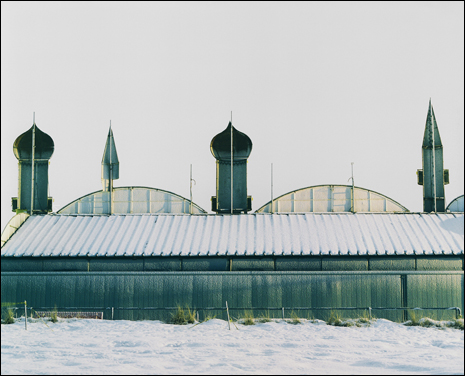
WARMTH IN COLD: "Old Orchard Beach #1," by Matthew Robbins.
|
|
"Genius Loci" | photographs by Nathan Eldrige + Matthew Robbins + John McNeil | through March 1 | at Whitney Art Works, 492 Congress St, Portland | 207.774.7011
|
Whitney Art Works for the next few days hosts the work of three Portland photographers (Nathan Eldridge, John McNeil, and Matthew Robbins) exhibiting entirely different but complementary approaches.
The cold steel that comprises Robbins’s industrial subjects is tempered by his eye for composition and technical prowess with color. Digital prints help the artist deliver the bluest of skies and whitest of snow. In “Old Orchard Beach #1,” powdery flakes rest delicately on an aluminum ridged roof. We see ornate boardwalk architecture head-on from the back alley, revealed as hollow façade with strong vertical lines echoed in the visible scaffolding, roof, and a foreground fence. Hollow proxies of two turrets and two cupolas protrude into a white-out sky complemented by a permeating teal green in the architecture. As cold as this scene should feel, there is a warm mask over the entire photograph, helped by the minor human presence of tracks in a small strand of snow in the immediate foreground.
“Tank #5, Snowstorm” takes Robbins’s knack for rigid composition turned sublime to its extreme. A large oil tank, familiar to any Portland-dweller, emerges from a spotted, snowy ground but is mysteriously barely visible. The artist manages to avoid photographing the storm while capturing its effects. The tank fades to near white, merging with the sky. Only a sharply contrasted numeral 5 and a few chips of paint give away its presence. The curvature of its roof is elegantly repeated in the bow of a chain-link fence in the foreground.
In “Tank Painter #1,” a direct frontal view of a tank’s staircase removes any perspective and curve such that steps become an extreme oblique running through the middle of the composition. Focus is sharp, but the prevalence of white maintains a sense of the dreamy symbolic. A lone painter, dressed mostly in white with a blue hard hat, hoists a black trashbag over his shoulder and begins a long climb from the lower right corner of the photograph. His sunglasses remove his humanity, he becomes a representative in a dream, and climbs to parts unknown.
Meanwhile, Nathan Eldridge is having a lot of fun in his darkroom. His work moves to equally surreal worlds, but through painterly manipulation of the camera and the lab. This intention is emphasized by printing onto canvas. Archaic Polaroid film captures a lone figure staring up at a spindly tree in “A Homecoming.” Focus is distorted so much that the subject almost disappears, becoming more like brushstrokes than film. The tattered edges of the negative are lovingly printed as part of the composition, framing the eerie scene.
Focus is more pulled in for “Resurrection,” from the same shoot. The figure jumps, captured by the camera hovering above the ground. The scene fades at its edges into cloudy obscurity met with abstract manipulation of the film. Emulsion runs into estuaries, disrupting the image with shapes reminiscent of coral reefs. A row of repeated circles from the negative frames the top of the work, juxtaposed with the softly rendered subject.
John McNeil’s still-life images reflect equally his adventuresome spirit and his technical ability. Climbing into dilapidated buildings, clock-towers, and foreboding apartments, he encounters beauty in the abandoned. “Precarious” is a close perspective of a crumbling diner table. Fallen plaster covers rusty remnants and a spoon perches just at the edge of the table, ready to fall if the photographer takes another step. Despite the murky locale, McNeil is able to capture every detail. What could be obscuring shadows become rich textures.
Nowhere is this talent in the darkroom more evident than “Queen Atlantic.” A black woodstove fills the frame, each curve producing a complex of reflections and shadows. The artist creates a deep sea of tone out of the obstinate object, a perfect backdrop for the punchline: a small skeletal mouse, head arched in death throes, crumpled on the hearth.
This exhibit creates a Genius Loci for itself because its constituent contributions make more than their sum, making the gallery a place of dreamscapes and hyperreal visions of the essence of place.
Ian Paige can be reached at
ianpaige@gmail.com
.